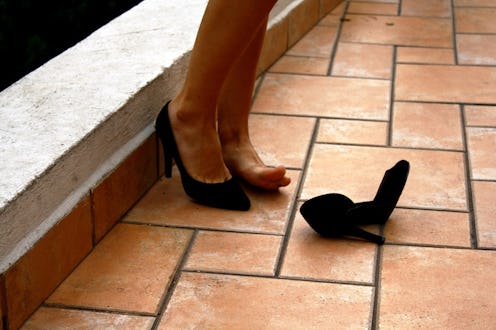
When a blister rears its ugly head, one of the first thoughts you contemplate (aside from wondering if you can wear slippers outside the house) is how to get rid of it. However, don't be too hasty; there's one thing you should never do to your blister that you need to know about before you go in with all guns blazing.
With blisters and certain types of pimples being similar in appearance — that is, a painful bump filled with liquid that's sprouted somewhere on your person, whose main existence appears to be to make your life a misery — you might feel tempted to treat them in the same manner. Although it's best to refrain from popping your pimples, I've yet to meet anyone who's never squeezed a glaring whitehead — if you've never had a pop at your pimples, I take my hat off to you. In the same vein, when a blister appears like a pesky, uninvited guest on a Friday night when you're in your PJs, eating pizza, and having some quality Netflix time, your initial reaction may be to immediately banish it from your bod.
However, as Dr. Janet Prystowsky, board-certified dermatologist and founder of Livad Skincare, shares with Bustle — there's one thing you should never, ever do to your blister.
"When you get a blister," says Dr. Prystowsky in an email to Bustle, "don’t pop it. Your skin is a natural barrier to bacteria and other infectious agents. Many times, when you have a blister, you do not have immediate access to sterile first aid supplies. If you try to pop your blister with any sharp object, you’re going to have a bad time."
"Instead, you should cover your blister with antibiotic ointment and a bandage. If it pops on its own, the bandage will absorb the fluid and the antibiotic ointment will help decrease risk of infection," she explains.
"Many times you’ll want to leave your blister alone. Reduce activity until you have time to heal. Sometimes, though, this isn’t an option. A blister on your heel may impact your ability to work, for example. I’d recommend visiting a clinic to have your blister drained professionally, but if you’re the type of person who pops their own blisters, it’s at least important that you know how to do it correctly," says Dr. Prystowsky.
So if you really can't let sleeping dogs lie, or rather, you can't resist bursting your blister, Dr. Prystowsky advises on the best method to safely drain a blister:
- Wash your hands and your blister with soap and water, and rub iodine on your blister to help prevent infection.
- Sterilize a sewing needle with rubbing alcohol as well. You can also use a lighter or other flame to sterilize, but the soot may collect on the needle. This is unlikely to be harmful, however.
- Insert the tip of the sewing needle into the edge of your blister.
- Remove the needle and allow your blister to drain. Add light pressure if necessary. Don’t peel. Leave the skin intact. It will still act as a protective barrier to the fresh skin underneath it.
- Apply an antibiotic ointment and cover with a new bandage.
After you've drained your blister, Dr. Prystowsky recommends, "Change the bandage every day. When you are resting, let your blister air dry. Look for signs of infection, like redness and pus."
I'm sorry to be the one to burst your bubble, but it's best to leave your blister alone. However, if you really can't stand it, go see your doctor to get it drained professionally or if you're up to the challenge, try safely draining it with Dr. Prystowsky's steps.
Images: Brooke Cagle (1) /Unsplash; TBIT (1), Senlay (1) /Pixabay